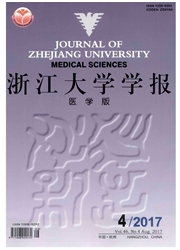

 中文摘要:
中文摘要:
目的:比较7种复方红藤汤次生代谢产物含量及其抑菌活性,确定进一步开发研究的目标化合物。方法:采用纸片琼脂扩散法测定抑菌圈大小,利用分光光度法对次生代谢产物含量进行测定,采用相关分析和通径分析的方法确定目标化合物。结果:7种复方红藤汤间次生代谢产物含量与抑菌活性均有显著性差异。6种次生代谢产物总量以术芍红藤汤最高,柴胡红藤汤次之,薏苡红藤汤最低;抑菌活性以术芍红藤汤最高,苍柏红藤汤最低。次生代谢产物含量与抑菌活性之间的相关分析和通径分析显示,影响复方红藤汤抑菌活性的次生代谢产物主要是总鞣质和总绿原酸。结论:7种复方红藤汤中6种次生代谢产物总量及抑菌活性均以术芍红藤汤最高,其抑菌活性与总鞣质和总绿原酸的含量密切相关。
 英文摘要:
英文摘要:
Objective: To compare the contents of secondary metabolites and the anti-bacterial activity of seven different compound Caulis Sargentodoxae decoctions. Methods: Kirby-Bauer disk agar diffusion method was used for measuring anti-bacterial activity. The contents of secondary metabolites were determined by spectrometry. The correlation and path analysis were used to identify the goal compound. Results: The secondary metabolites contents and anti- bacterial activity of seven different compound Caulis Sargentodoxae decoctions varied significantly. The total contents of six secondary metabolites of Shushao Caulis Sargentodoxae decoction was the highest, while that of Caihu Caulis Sargentodoxae decoction was the second highest and that of Yiyi Caulis Sargentodoxae decoction was the lowest. The anti-bacterial activity of Shushao Caulis Sargentodoxae decoction was the highest and that of Cangbai Caulis Sargentodoxae decoction was the lowest. The correlation and path analysis showed that the total tannin and total chlorogenic acid might be the major factors related to the anti-bacterial activity of compound Caulis Sargentodoxae decoctions. Conclusions: The total contents of six secondary metabolites and the anti-bacterial activity of Shushao Caulis Sargentodoxae decoction are the highest among seven different decoctions and there is a significant correlation of the anti-bacterial activity with the contents of total tannin and total chlorogenic acid.
 同期刊论文项目
同期刊论文项目
 同项目期刊论文
同项目期刊论文
 期刊信息
期刊信息
